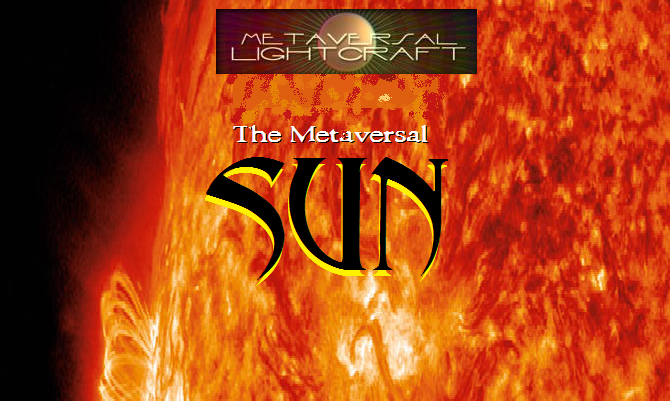 Between dark and light the angles of times are best manifest at their balance, so invoke Apollo, Ra, or the baby-faced Sun god from the Teletubbies into your heart Chakra today. Sunday is always a good day integrate all the planets in our personal Lightcraft. In the World of Yetzirah, Air, the Lightcraft is analogous to the active aspect of the psychological body, or for simplicities sake, let's call it Psyche. In the physical body (in Assiah) there are infinite subdivisions down to the frontier of the physical world, where the particles of matter and impulses of energy are interchangeable. In the same way,the Psyche interpenetrates the body so that the upper part of the physical world percolates and influences the lower part of the psyche, and vice versa. In the macrodimensions of the Metaverse, a crisis can generate a direct contact with the Sun in Yetzirah (Psyche) but after the crisis, the connection fades, and the watcher in oneself fades back into the subconscious. The Lightpilot seeks to consciously make permanent connection with the Sun in Yetzirah. This is done by constant observation of actions, emotions and intellect, to perceive impartially the way those functions operate, and to correct and perfect their performance so as to become a true seething. To be the big picture, complete in all its partsIt might seem as if we stepped out of our real lives and onto a set of a “Twilight Zone” episode. However, pinching ourselves proves the current situation is the real deal. The cosmic lovers, Venus and Mars, engage with surreal Neptune in a bubble of fantasies. It’s nearly impossible to know what is factual. Thankfully, we can build confidence by setting and accomplishing realistic goals. Small successes go a long way to improve self-esteem. On Jan. 19, 2019, just 161 days after its launch from Cape Canaveral Air Force Station in Florida, NASA’s Parker Solar Probe completed its first orbit of the Sun, reaching the point in its orbit farthest from our star, called aphelion. The spacecraft has now begun the second of 24 planned orbits, on track for its second perihelion, or closest approach to the Sun, on April 4, 2019. The Parker Solar Probe, shown in this animation, became the closest-ever spacecraft to the Sun.
Between dark and light the angles of times are best manifest at their balance, so invoke Apollo, Ra, or the baby-faced Sun god from the Teletubbies into your heart Chakra today. Sunday is always a good day integrate all the planets in our personal Lightcraft. In the World of Yetzirah, Air, the Lightcraft is analogous to the active aspect of the psychological body, or for simplicities sake, let's call it Psyche. In the physical body (in Assiah) there are infinite subdivisions down to the frontier of the physical world, where the particles of matter and impulses of energy are interchangeable. In the same way,the Psyche interpenetrates the body so that the upper part of the physical world percolates and influences the lower part of the psyche, and vice versa. In the macrodimensions of the Metaverse, a crisis can generate a direct contact with the Sun in Yetzirah (Psyche) but after the crisis, the connection fades, and the watcher in oneself fades back into the subconscious. The Lightpilot seeks to consciously make permanent connection with the Sun in Yetzirah. This is done by constant observation of actions, emotions and intellect, to perceive impartially the way those functions operate, and to correct and perfect their performance so as to become a true seething. To be the big picture, complete in all its partsIt might seem as if we stepped out of our real lives and onto a set of a “Twilight Zone” episode. However, pinching ourselves proves the current situation is the real deal. The cosmic lovers, Venus and Mars, engage with surreal Neptune in a bubble of fantasies. It’s nearly impossible to know what is factual. Thankfully, we can build confidence by setting and accomplishing realistic goals. Small successes go a long way to improve self-esteem. On Jan. 19, 2019, just 161 days after its launch from Cape Canaveral Air Force Station in Florida, NASA’s Parker Solar Probe completed its first orbit of the Sun, reaching the point in its orbit farthest from our star, called aphelion. The spacecraft has now begun the second of 24 planned orbits, on track for its second perihelion, or closest approach to the Sun, on April 4, 2019. The Parker Solar Probe, shown in this animation, became the closest-ever spacecraft to the Sun. “It’s been an illuminating and fascinating first orbit,” said Parker Solar Probe Project Manager Andy Driesman, of the Johns Hopkins University Applied Physics Laboratory. “We’ve learned a lot about how the spacecraft operates and reacts to the solar environment, and I’m proud to say the team’s projections have been very accurate.”The Sun—the heart of our solar system—is a yellow dwarf star, a hot ball of glowing gases. Its gravity holds the solar system together, keeping everything from the biggest planets to the smallest particles of debris in its orbit. Electric currents in the Sun generate a magnetic field that is carried out through the solar system by the solar wind—a stream of electrically charged gas blowing outward from the Sun in all directions.The connection and interactions between the Sun and Earth drive the seasons, ocean currents, weather, climate, radiation belts and aurorae. Though it is special to us, there are billions of stars like our Sun scattered across the Milky Way galaxy.

